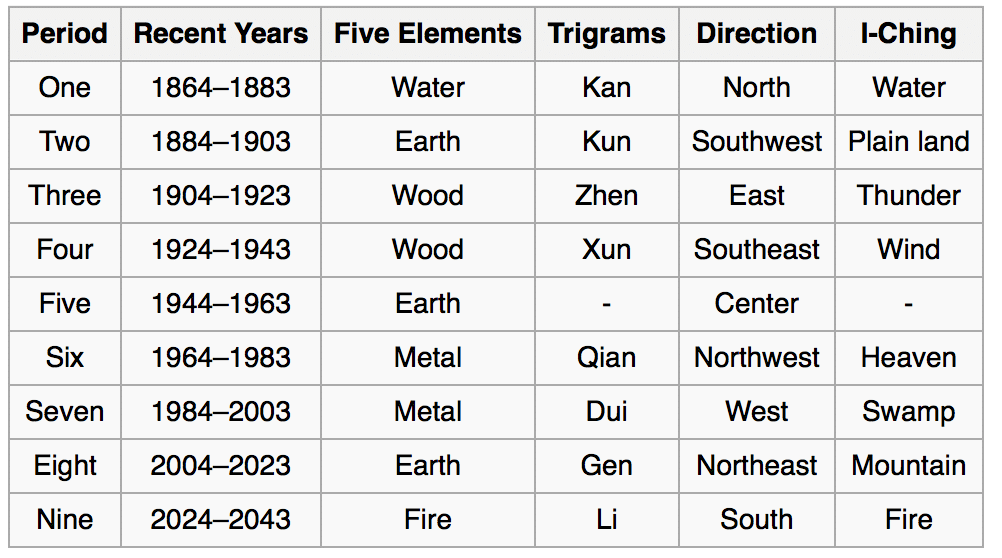In this article I’ll examine the macro aspects of London’s Feng Shui, in term of topography, layout and landscape. London is the most expensive European capital, in term of housing prices but also for…pretty much everything else, along with Paris oh la la…It is also the European cocaine capital, as measured in tap water, for a second year in a row: congrats London!
True, London has plenty to offer for the discerning people who try to survive there, such as: a terrible weather, insane traffic, high level of pollution and the need for a bank loan if you go out more than twice a month. Ok, just kidding, the French in me couldn’t resist! London has indeed a great cultural life and restaurants, but that doesn’t explain why the price of real estate has skyrocketed over there in recent decades to reach levels that are not really affordable for the middle class anymore. In fact, based on study by the real estate agents Savills, London is the most expensive city in the world to live in.
A place commanding some of the highest prices on earth in real estate for flats, houses and business necessarily has some excellent Feng Shui in the landforms and city layout. Time for us to explore what is special in the Feng Shui of London then.
London’s topography
First, you might be surprised to see Feng Shui used in such context, if you believe that the terms only apply to interior design and architecture. Far from it, Yang Feng Shui is in it classical form and origins first and foremost the choosing of excellent surroundings which provide a Chi, or energy, that can sustain life and prosperity for humans settling in this area. In classical Feng Shui, the landforms then tell the whole story. While in modern days a skilled consultant can do a good job at correcting the layout of your home through a Feng Shui consultation combined with interior design, the choice of a location technically matters even more and must be based on the auspicious landforms around. As real estates agents around the world like to say: location, location, location!
What are the landforms we are interested in Feng Shui then? Mostly they are of two kinds: mountains and water, as in rivers, lakes and sea. In London, there are no mountains whatsoever and only a few hills. Mountains and high hills are significant in landforms, as their shapes can bring prosperity or crimes to the neighborhood, depending of the quality of their Chi and the time period. We Feng Shui consultants classify mountains based on their shapes and liveliness of their Chi: some are called left assistant, XXX. It goes back to the 5 Elements theory and classification as each mountain shape can bring a different type of dominant Element in the picture.
In London, mountains or hills are not relevant, which is a different setup from Lisbon or Florence for example, where the nearby hills all influence the fate of the city. In the UK, the analysis of the landscape would be different for Edinburgh for example, which benefits from nearby mountains.
The next aspect we look at is Water. Water, it can be argued, is one of the most important factors in Feng Shui. It can make or break a home setup, but also greatly influences the destiny of a city. Historically and geographically, it sense that many important cities have been built around large rivers, as those were means of transporting goods relatively easily. Paris, Amsterdam, Berlin, Rome, Budapest, Moscow, Zurich, Buenos Aires are some of the capital cities built around a river. Most European capitals are actually built around a river.
http://10mosttoday.com/10-rivers-that-flow-through-europes-capital-cities/
London is no exception. This is where it gets interesting for the Feng Shui nerds. First, if an enduring capital city has been built around a river, it means that the flow of this river and its shapes must be auspicious in term of the landform. A river flowing too fast for example does not bring prosperity to the city, but can rather take it away. Second, the river placement for the city itself and its different part has a timely influence and this is where we must talk of the time period.
Time periods in Feng Shui: understanding prosperity with timing.
In Feng Shui we use a concept called time periods. During a given time period a landform such as a mountain type, or a river, can be either supportive or to the contrary negative to the nearby cities. As the period changes, so does the influence of the landforms…This partly explains the cycle into which some major cities go through, with prosperity for some decades and then some recession. Chicago and Detroit are two very good examples with the proximity of the great lakes, but so are Paris, London, Rome and Lisbon Europe. Sometimes it is due to the change of influence of the river, sometimes the nearby sea, sometimes the mountains, and often a combination of those factors.
Of course, as the capital city is a focal point and representation of a whole country, the fate of every one of them affects the whole country. When history had Paris, which at the time was named Lutecia, replacing the former capital Mysenia (currently Marseilles); or when Roma replaced Florencia and Lisbon Porto, the fate of those countries changed quickly. I would argue that when those former capitals have lost their status, it was also because the landforms of the Feng Shui setup for the period already changed and was not favorable to them anymore…
Some leaders understand this connection, but take it a bit too far. In Myanmar, formerly Burma, the capital city was moved from Rangoon to an artificially created spot in the jungle named Naypyidaw. What few people know is that the Burmese leader decided to do so on the advise of his trusted geomancer, using the local equivalent of Feng Shui. This fellow might have made a few mistakes in calculation as the new capital city never took off, and like Canberra in Australia it is mostly an administrative city devoid of the life of bigger cities in the country. https://www.theguardian.com/cities/2015/mar/19/burmas-capital-naypyidaw-post-apocalypse-suburbia-highways-wifi
Back to London then! In London we have the Thames, and one of the Thames bend is close to some of the most expensive areas in London. Which areas are we talking about then?
The most expensive areas in London.
Here is a map of the rental and selling prices in London.
According to this real estate article, the most expensive London neighborhood are:
- Kensington W8
- Chelsea SW3
- Knightsbridge SW7
- Notting Hill W1
- West Brompton SW10
I have listed the postcode so you can see that the top 5 are ALL in West and Southwest area of London…
Now here is a map of London figuring the Thame’s river course.
http://images2.intolondon.com/img/intolondon/postcode-map-of-london.gif
If you look at the river course and bends over London, some of the most expensive areas are near the “softest” part of the river, with a portion that is almost straight embracing an area between Pimlico and Chelsea banks. This is significant: it is an area where the Chi of the river does not meander or bend, but rather brings a constant flow (of prosperity) to those banks and at the right pace.
Moreover, the placement of the river, in term of direction/sector, is most important in classical Feng Shui. Let’s now look at the direct/indirect spirit theory.
Placement of water with landforms: the direct/indirect spirit theory.
To understand this classical theory, we need to go back to the concept of time period in Feng Shui. I have mentioned that for a given period, a landform can be auspicious or inauspicious for a given area. This is due to Yin/Yang and Chi cycles – we could call them the “macro” seasons of Feng Shui. Of course in winter you are not going to grow plants like in summer, and so cities and countries have their winter and summer, depending of the landforms and time periods.
I include below a table of the time periods used in Feng Shui, taken from this Feng Shui article on Wikipedia.
A well-known application of the period is for the Flying Stars school, but they are also used in San He and Han Wu San Yuan Feng Shui. We are currently in period 8 which started in 2004 and will finish in 2023, included. So what is this direct and indirect spirit formula? Though a mathematical formula, it basically gives a pattern where a city or a home should see water for the given period of time, and where it should not see it. The idea is that the “weak” areas of the Chi for this period should be revitalized with a natural water flow, and the one already strong for the period should not receive any. If a glass if already full, you don’t want to add more water on top of it…
A very important point here is that the water must come from natural landform placement. The positioning of a pool or other man-made water feature is not counted into the direct/indirect spirit formula.
Another very important point is that local landforms must be taken into account as they can either contradict or confirm this formula. In a city like Lisbon, every hill must be analyzed for its influence on the city: the placement of Water through the direct/indirect spirit formula, looking at the city and river in town, is not the only point to account for the current economic troubles of Portugal and its capital city.
In London however we are mostly dealing with a flat city and the hills are very few. They exist however, most notably in the North and Northeast area of London: this will take all its importance in this analysis. For now we look at the other most important point, the course of a natural body of water and its influence on the city’s destiny. The formula is also to be adapted by analyzing the bends of the river and the intensity of the water flow in given area. As previously mentioned, a water flowing too fast does not bring prosperity and health, but rather takes it away…
Here is the ideal placement of the Water Element through landforms for this period 8. For this period, the Water should be seen through landforms in the following sectors:
- Southwest
- Southeast
- East
- North
Now, let’s apply this macro-theory to the landscape of London.
The Thames river: one key to understand London wealthiest areas.
In period 8, the BEST sector to have Water for the period 8 is in the Southwest, as it is the opposite of the direct spirit that is in Northeast (Gen Gua). If we take the map of London, do we see the Water in Southwest of London? Indeed we do. Do we also see that the best area to have Water through a natural landform pattern for this period 8 IS the most expensive of the city for this period? Indeed: Southwest London IS the most expensive neighborhood of London in term of real estate. Actually, greater London has both conditions to thrive during this period 8: the Water is flowing in the Southwest, and in Northeast we have an elevation made by Buckhurt hill. While not a mountain, it is a higher point for London which overall seems to perfectly correlate with the Feng Shui landform predictions.
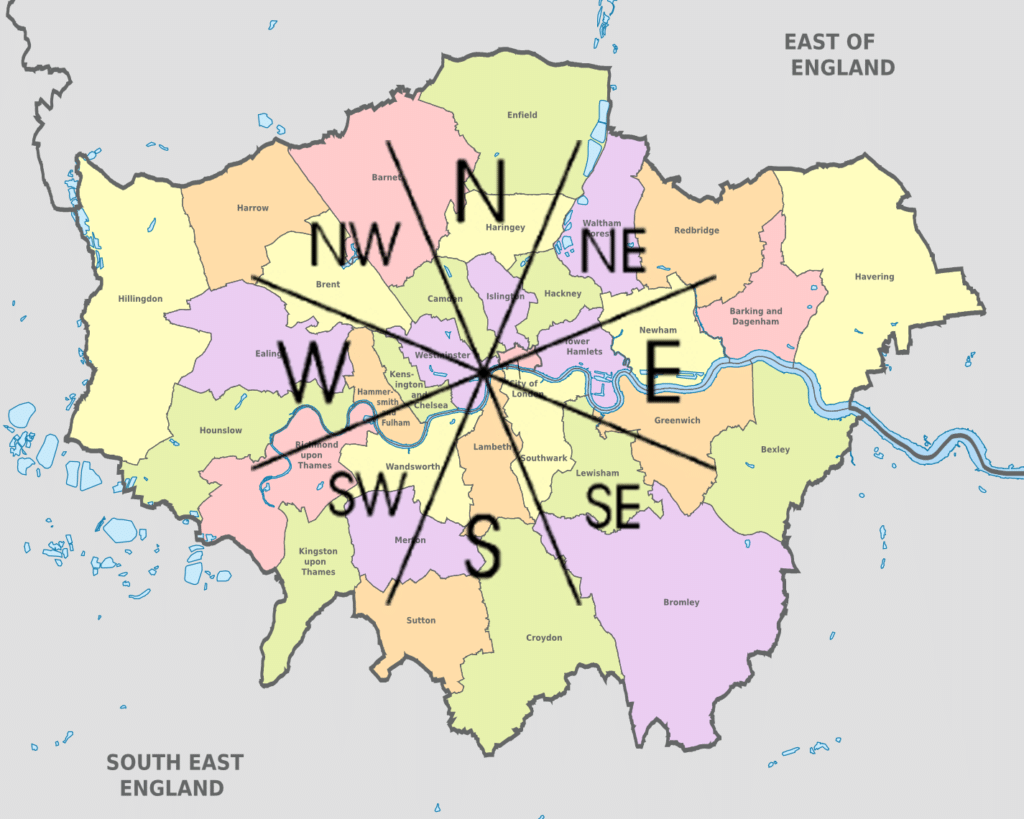
The 8 directions and sector of London: see which ones sees the water flow of the Thames. Copyright: Laurent Langlais 2016.
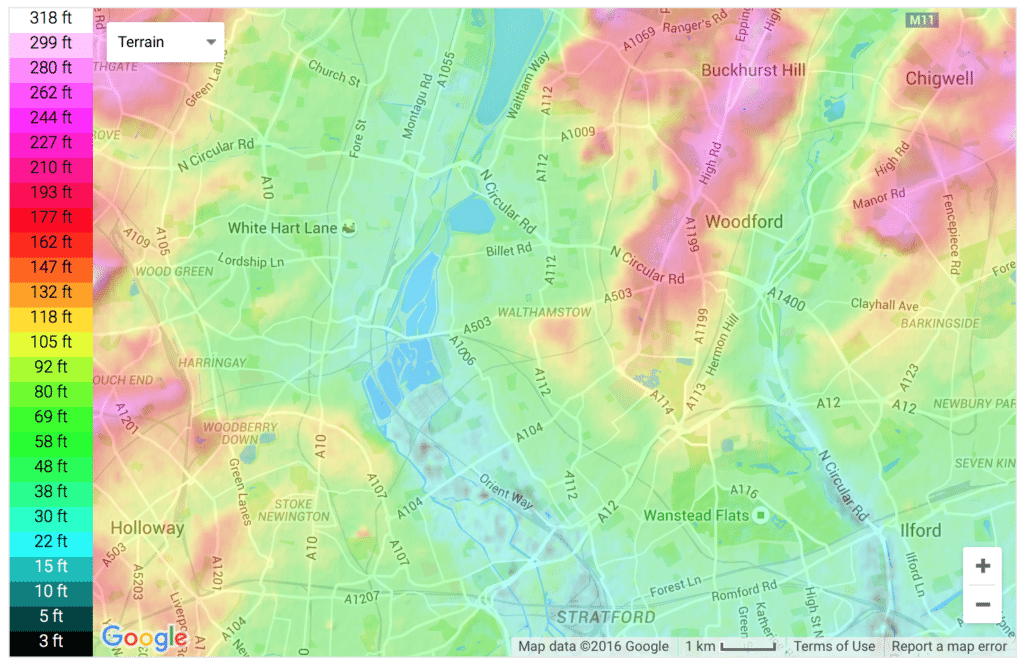
London topographic map. See the highest points located in Northeast London. From http://en-gb.topographic-map.com/places/London-92172/
Let’s go further with this theory. Based on the centre of London, which is Charing Cross, if we put a diagram with the 8 sectors, you can see that London actually has most of the course of the Thames running through the Southwest and East area, with some in Southeast. This is 3 out of the 4 auspicious sectors for the period. London has also virtually no water running in the “challenging” sectors for the period, as it’s not good to have water running through Northeast, Northwest, West and South.
Still, there is a small part running in South and some in the far side of the West area of London, but none in the other sectors – especially Northeast which is the one to really avoid for this period. Shall we expect trouble for the areas of the cities that see the Water flow where it should not be for the period? You bet! Note that the part in South and West London where the Thames is running are some areas where the real estate does not command the same high prices anymore: Housnlow and Fulham, Lambeth are all areas where criminality is high for London, and they are area where water for the period can bring agitation and criminality…And so the theory is confirmed for the whole city by affecting some areas positively and some negatively, translating either in prices skyrocketing or higher criminality.
Once we have seen the pattern for the whole city, we must look at the pattern of the specific prosperous areas. If we look at the area delimited by the most expensive neighborhoods in West/Southwest London, they also answer to the formula by seeing a positive water flow in mostly East, Southeast and above all Southwest. There is a small portion running in South, but with 3 auspicious areas vs one, clearly the balance is overwhelmingly good.
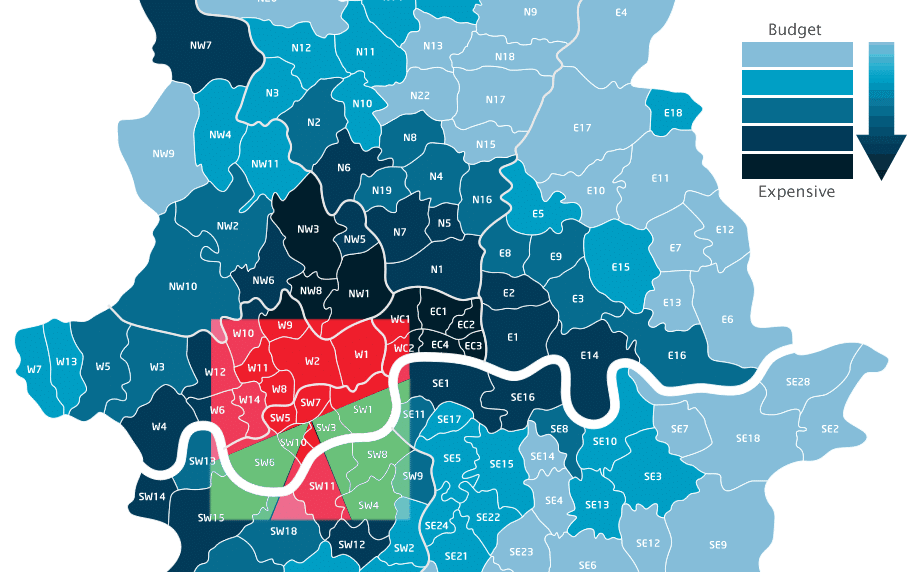
Water placement respective to the most expensive London SW and W areas. Copyright: Laurent Langlais 2016. Map: www.intolondon.com
So we have a repeating pattern here. Part of the Southwest and West London command the higher prices both because the whole city of London sees a natural water flow in Southwest and because respectively for those boroughs, the river flows in their Southwest, East and Southeast sector. We therefore have the manifestation of all the positive aspects of the water placement for the time period and the area in the macro analysis of Feng Shui.
But wait a minute…Surely there are other areas in London that sees the water placed in Southwest and Southeast? Isle of Dogs is one for example? Why do they not command the same high prices then? One of the points that I have made previously is that the general formula work if the landform confirm it. It works perfectly well for Southwest London BECAUSE the course of the river at this particular location is ideally flowing for the whole Chelsea area, having the only “straight” course of the Thames in the whole city. The direction and pace of the slow by the bank is here ideal to bring prosperity to the nearby neighborhoods. This situation is not reproduced in other part of London, in regard to the bends and shape of the Thames River. There is also more to those boroughs, as we’ll see in the last part of this article.
If you keep applying this area by also factoring the shape of the river, you will start to understand while Lambeth is still crime ridden, and while the next borough Vauxhall is however experiencing a spectacular rise with the US embassy moving there which in return bring new real estates development and very high prices. Vauxhall fares much better because it sees the water of the Thames in North and Southwest area that are very auspicious for this period– with only a little one in the Northwest and the West, a problematic placement. And so Vauxhall is experiencing some prosperity. Lambeth on the other hand sees way too much in the West and Northwest area, much more than Vauxhall and not enough in North and Southwest. This has a direct influence on the life in those boroughs, on safety and on the prices of real estate. It can be balanced out energetically through some architecture, but it is a complex work. If only city planners and urban designers would call Feng Shui experts more often, a lot could be done for a city. Sadiq Khan, mayor of London, feel free to get in touch!
There are a last few points to take into account explaining while West and Southwest London are so spectacularly expensive in London, and in the world.
Parks and nature: how the natural Chi can bring prosperity in a city.
There are two last factors that explain the amazing values of London’s properties located in some of the West and Southwest areas. If you look at the map of London, you’ll see clearly what those neighborhoods have that most other London areas don’t….
The most expensive London areas are sandwiched between the Thames rivers and large pockets of nature. The Kensington gardens and Hide park as well as Green park provide the areas with a very vibrant, lively Chi. Even the Brompton cemetery does, to some extent! You will see this pattern in most big cities with a large urban density: the live Chi provided by nature, especially trees, always increases the value of the nearby properties tremendously. A down to earth psychological explanation is because of the view, but energetically it makes a lot of sense. In a place when most of the surrounding Chi is man-made and artificial, the presence of a lively natural Chi is a game changer that everyone can feel at an intuitive level. Look at the value of the properties next to Central Park in Manhattan, Stanley Park in Vancouver, etc. In traditional Feng Shui, there is the concept that vibrant woodlands bring prosperity to the nearby dwellings – and this is still understood in part of China such as Hong Kong. For London, do note that another area commanding high prices is the one around Hampstead Heath, another very large pocket of vibrant Wood Chi in the city. The irony is that what we end up destroying to build cities becomes one of the most valuable factor for the properties values inside the city; and what urbanites run away from – a countryside dwelling close to nature – becomes what they are craving for in the city. Yin and Yang at works!
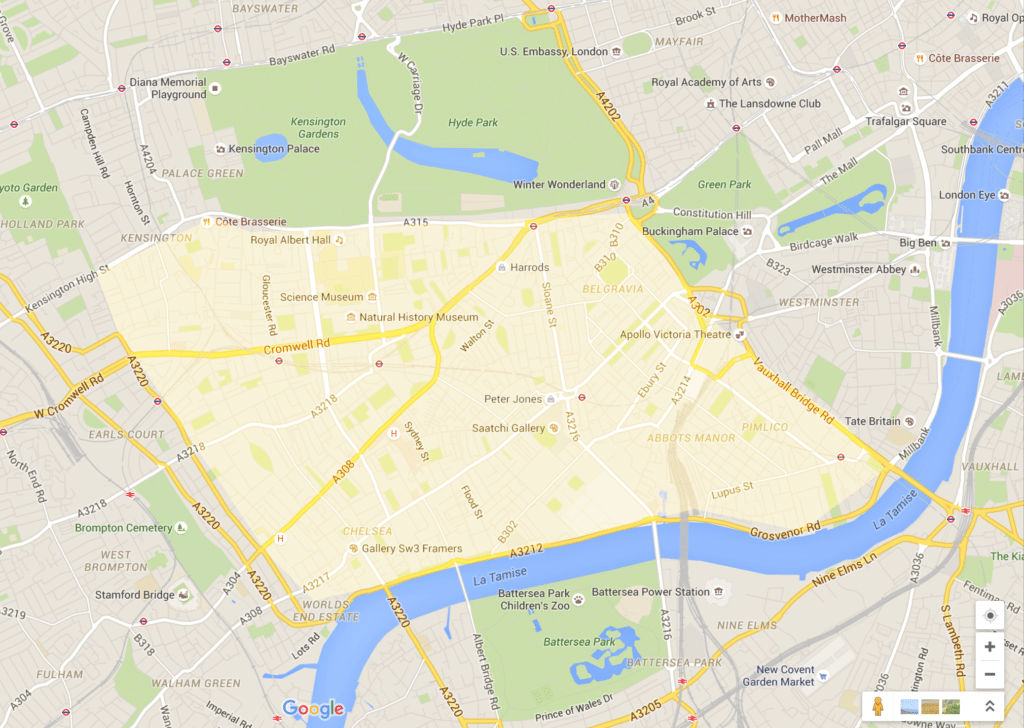
The golden square of most expensive properties is between the Thames and green areas in SW and W London. Copyright: Laurent Langlais 2016.
Finally, while human made buildings cannot compete with the vibrant Chi of nature, when buildings are harmonious and have gone through the ages well preserved, they have acquired a Chi of their own that also increases their value. This is the case of the properties in West and Southwest London. Isle of Dogs, for example, is made of much more recent constructions with less appeal. Large structure that become iconic also focus the Chi in the city, and can partly replace a deficient natural Chi that is lacking. To act as points of harmonious Chi they must however be aesthetically pleasing and providing “beauty”: with modern buildings, it is sometimes debatable! In London some the energetic points that increase the liveliness, Chi and eventually values of the nearby areas are:
- Buckingham Palace
- Trafalgar square, especially the obelisk?
- The British museum
- The Saint Paul Cathedral (when it’s not used by Cybermen and Missy to conquer the world).
Modern structures:
- The London eye
- The Gerkhin
- The SIS building, MI6 headquarters
- The Shard
A future article will look more in details as the shapes, colours, and effects on their surroundings of modern buildings in London, through the analysis of their 5 Elements.
As you can see, the wealthiest areas in London can be understood through a macro-Feng Shui setup and analysis, that takes into account:
- the course of the Thames River,
- the placement of such areas around the water,
- the proximity of natural Chi in its urban environment,
- the added Chi made by human artistry or buildings
- the dynamics of the current time period.
Predicting the future of London with Feng Shui patterns.
Now, can we use the same formula to see in the future? We can, but we also have to account to the worlwide influence at work in the following years. What will happen to those prosperous and less prosperous boroughs in London during the next Feng Shui time period 9, which goes from 2024 to 2043? Actually the pattern for the placement of water that brings prosperity remains the same in period 9: we can therefore expect those areas to still have a very high value. The subtle difference is that the direct spirit will not be in the Northeast direction anymore, but in South. So the opposite and most prosperous area will not be Southwest – which still remains good – but rather in North now. This means that from 2024 onward, North London is the area most likely to see the biggest increase in properties value: especially for the ones located nearby Hampstead Heath, as they will benefit from the natural Chi of the park. The advantage of Chelsea areas and SW London will however remains due to the proximity with the Thames river. Feng Shui wise, the real negative game changer for London will be the period 1, from 2044 to 2063. This one will totally change the dynamics of the water placement for all places and will see cities with Water in the Southwest, Southeast, East and North decline, and those with Water in South, West, Northwest and Northeast rise again (of course, this is generally speaking and the local landforms will need to be examined carefully).
On top of this we have to add a Bazi/Four Pillars analysis of each year to see if they are favorable to real estate or not. The yearly Flying stars (or to some the method known as 9 Star Ki) further help to localise countries or cities that might be in trouble. What I foresee in my predictions is that 2017, Yin Fire Rooster year, will be a troubled one and a bit more complicated for luxury placements. 2018, Yang Earth Dog year, is good for real estate but slow overall. However the problems could really hit in 2019, Yin Earth Pig year and 2020, Yang Metal Rat year. Those years in my opinion show a great lack of stability for several markets, including real estate and luxury. So if you plan on reselling a London property and especially a luxurious one, try doing it before 2019 which could see the bubble crash badly. The recovery could then happen in 2021, but probably not before. More on this soon in one of my Bazi article.
Excellent Feng Shui: combining macro and micro-environments.
Once you understand the macro-environment of an urban landscape, you also have to make sure your personal environment is supportive to your life. There is much to be gained by understanding the logic of the surroundings and what brings prosperity or challenges, in term of urban planning. If you are an urban planer, a mayor, an architect or working in real estate, feel free to contact me now to understand how we can collaborate and create a more harmonious world.
Besides helping you to determine the best areas in a city and select the best possible home, the point of a Feng Shui home consultation is to create harmony through the internal layout and design of your flat or house, or to increase your success with a Feng Shui business and office consultation. My techniques combine the accuracy of classical Feng Shui with the added precision of your Bazi/ 4 Pillars of destiny analysis and the understanding of the challenges you are going through in a modern, stressful city. If you are now ready to thrive with your business or to create a safe haven at home that will sustain your personal development and happiness, contact me now to book your consultation and change your life for the better.

